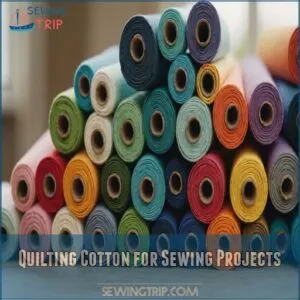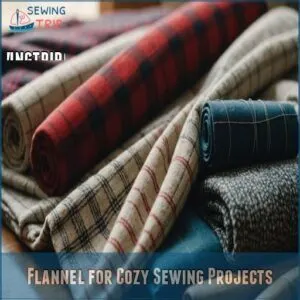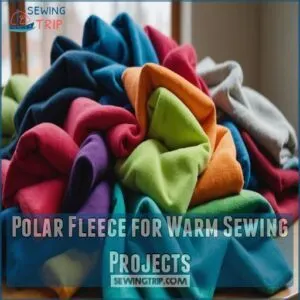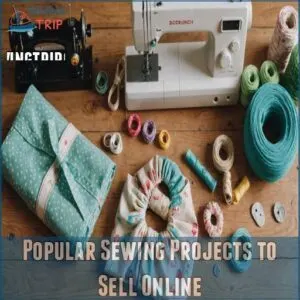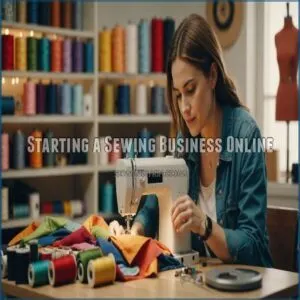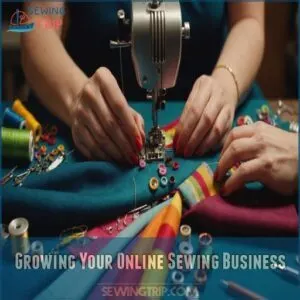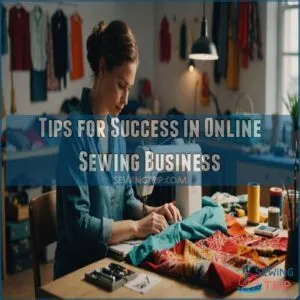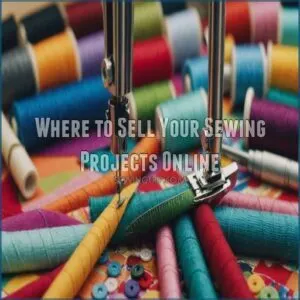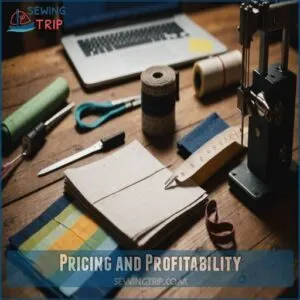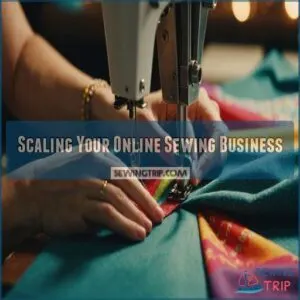This site is supported by our readers. We may earn a commission, at no cost to you, if you purchase through links.
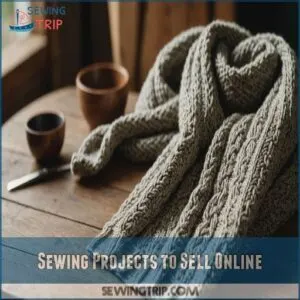
Popular choices include scrunchies, headbands, and pillow covers—all relatively quick to make and highly profitable. You’ll control your hours and pricing, creating the life you want.
Start by researching what’s trending; analyze what sells well on sites like Etsy. Then, choose your fabrics wisely—quilting cotton is versatile, flannel is cozy.
Using PDF patterns makes things super easy, especially for beginners.
Ready to turn your passion into profit? We’ll show you how to find your perfect niche and more…
Table Of Contents
- Key Takeaways
- Sewing Projects to Sell Online
- Choosing The Right Fabric
- PDF Sewing Patterns for Beginners
- Popular Sewing Projects to Sell Online
- Starting a Sewing Business Online
- Growing Your Online Sewing Business
- Tips for Success in Online Sewing Business
- Where to Sell Your Sewing Projects Online
- Pricing and Profitability
- Scaling Your Online Sewing Business
- Frequently Asked Questions (FAQs)
- Conclusion
Key Takeaways
- Identify trending items like scrunchies and pillow covers to tap into profitable markets and maximize your sales potential.
- Use PDF sewing patterns for easy printing and customization, allowing you to efficiently produce a variety of items.
- Engage in market research to understand seasonal demands and customer preferences, helping you tailor your offerings effectively.
- Optimize your online selling with platforms like Etsy and by using social media for marketing, ensuring you reach a broad audience.
Sewing Projects to Sell Online
If you’re thinking about selling your sewing projects online, you’re in for a rewarding adventure where creativity meets business.
From trendy scrunchies to decorative pillow covers, you’ll discover the best-selling items and learn how to pinpoint profitable products with a touch of flair.
Best-Selling Sewing Items
Ready to tap into your entrepreneurial spirit? Scrunchies are huge right now! They’re super popular, easy to make, and boast great profit margins.
Think adorable headbands too – they’re always in demand. Don’t forget cozy pillow covers; everyone loves a comfy home.
These best-selling sewing items offer fantastic returns, especially considering low fabric costs. Start selling your handmade items online today!
How to Find Profitable Products
Thinking about those best-selling items? It’s time to uncover profitable products! Start by:
- Trend Analysis: Keep an eye on what’s hot.
- Customer Feedback: Listen to buyers’ needs and wants.
- Competitor Research: Check out what’s flourishing.
- Seasonal Demand: Align your creations with the seasons.
These steps will help you stitch up a successful online selling venture.
Market Research for Sewing Projects
You’ve nailed down profitable products, so now it’s time to uncover the magic of market research for your sewing projects.
Explore local demand and competitor analysis to zero in on trending items, checking out popular online stores like Sewing project stores.
Get friendly with customer demographics and seasonal trends.
By understanding your target audience, you’ll craft handmade gifts that aren’t just stitched, but stitched smartly for your online business.
Choosing The Right Fabric
Picking the perfect fabric is like choosing the right thread for your sewing machine—it’s essential for crafting top-selling items.
You’ll want to explore options like quilting cotton, flannel, polar fleece, and sweatshirt fleece to match your project needs and delight your customers.
Quilting Cotton for Sewing Projects
Explore quilting cotton! It’s not just a fabric; it’s the heart of sewing projects, offering variety and durability. Think handmade quilts and sewing patterns that spark creativity.
Here’s why it’s essential:
- Variety in quilting cotton types keeps your projects unique.
- Easy quilting cotton care saves time.
- Endless quilting cotton patterns inspire.
- Reliable quilting cotton suppliers guarantee quality.
Flannel for Cozy Sewing Projects
Flannel, the epitome of warmth, is your go-to for cozy sewing projects.
It’s perfect for crafting infinity scarves, fleece hats, and cute hand warmers.
Explore flannel sewing patterns to unleash creativity, and source vibrant flannel fabrics for eye-catching projects.
Remember, flannel care tips keep your creations looking fresh.
Embrace flannel’s softness and watch your creations bring warmth and smiles!
Polar Fleece for Warm Sewing Projects
Imagine bundling up in polar fleece on a chilly day. It’s cozy and lightweight, making it perfect for warm sewing projects like jackets or hats.
Consider the vibrant colors available—ideal for eye-catching designs.
Try experimenting with simple patterns for beginner success.
Remember, polar fleece doesn’t fray, so you can skip the hassle of finishing edges!
Sweatshirt Fleece for Casual Sewing Projects
Several types of sweatshirt fleece offer amazing options for casual sewing projects you can sell online.
Think cozy hoodies or joggers!
Its durability makes it perfect for everyday wear.
Consider the weight; heavier fleece is warmer, lighter fleece is more versatile.
Explore current color trends to boost your sales.
Easy care instructions are a plus for your customers.
Compared to cotton spandex jersey, sweatshirt fleece offers a different feel and drape.
Don’t forget to check out project ideas online for inspiration!
PDF Sewing Patterns for Beginners
If you’ve ever lost a paper pattern under a mountain of fabric, PDF sewing patterns might just save your day.
These digital patterns are beginner-friendly, easy to print, and perfect for starting your creative sewing journey.
What is a PDF Sewing Pattern?
After exploring fabric choices, let’s chat about PDF sewing patterns.
These gems let you print your sewing projects from home!
Adjust print settings for accuracy—think pattern scaling—and print these on letter or A4 paper.
With personalized items as your ultimate goal, creating a sellable PDF sewing pattern requires thorough market analysis and understanding of your target customer to identify gaps and trends, learn how to make pdf patterns to sell. PDF sewing patterns help you turn digital designs into real, eco-friendly products.
How to Use a PDF Sewing Pattern
Why are PDF sewing patterns so handy?
First, make sure your printing settings are at 100% scaling, or your circle drawstring bag might end up more like a coin purse!
If you’re planning to sell your sewing projects online, checking out an Etsy shop guide can help you get started with setting up your store and listing your products.
After printing, get ready for a bit of arts and crafts: assemble by cutting and taping the pieces together.
Start by considering projects like a phone-charging station or a portable first-aid kit from various beginner sewing projects. Then, let your sewing machine bring those sewing project ideas to life!
- Check print settings: Make sure 100% scaling
- Assemble: Cut and tape to fit
- Create: Use sewing machine to begin sewing projects
Benefits of PDF Sewing Patterns
Embrace the magic of PDF sewing patterns. They let you print at home, enhancing your creativity and control.
It’s cost-effective—reprint anytime if you spill coffee on them (no shame, we’ve all been there).
Plus, keeping them organized with a consistent labeling system can save you hours of frustration.
Their scalability and customization options make them versatile for any project.
From beginners to small business owners, these patterns boost your sewing endeavors—and revenue estimates!
Popular Sewing Projects to Sell Online
When you’re looking to make some extra cash with sewing projects, starting with items that are in high demand can really help, like scrunchies, which are a popular sewing project, and why not start with popular items like scrunchies and pillow covers?
These creative projects are in line with current trends and are also fun and easy to sew, bringing joy and profit.
Scrunchies and Hair Accessories
You’ve mastered PDF sewing patterns, now make magic with scrunchies and hair accessories!
These trendy pieces are fun to create but also a hit among buyers.
Consider these styles:
- Scrunchie trends
- DIY hair bows
- Upcycled scrunchies
- Premium scrunchies with eco-friendly materials
- Influencer marketing on social media
Simple ideas, big monthly revenue!
Home Decor Items Like Pillow Covers
Many crave unique home decor, and pillow covers are a fantastic option!
They’re surprisingly simple to make, offering tons of creative freedom.
Explore Pillow Cover Styles and trends; experiment with Pillow Cover Fabrics.
Custom Pillow Covers are hot!
| Style | Fabric | Design Idea |
|---|---|---|
| Boho Lumbar | Cotton, Linen | Tassels, embroidery |
| Modern Square | Velvet, Silk | Geometric patterns |
| Farmhouse | Denim, Gingham | Appliqué, patchwork |
| Kids’ Theme | Cotton Prints | Cartoon characters |
| Elegant Floral | Brocade, Satin | Lace trim, buttons |
Reusable Bags and Snack Packs
Imagine crafting eco-friendly options like reusable snack packs and drawstring bags.
These projects combine creativity with practicality, making them perfect for selling online.
Choose vibrant fabrics that catch the eye, and experiment with design ideas.
Share your creations on platforms like Etsy.
Remember, a well-organized sewing table helps maintain productivity.
Jump into this trend and watch your sewing business grow!
Baby and Kids’ Items Like Quilts
From crafting reusable snack packs, let your creativity run wild with baby quilts and kids’ items!
Picture vibrant baby quilt styles, soft baby clothes, and adorable baby tag blankets.
Every stitch tells a story, sparking joy in custom orders with thoughtful fabric choices.
Consider adding baby bandana bibs and quilted pot holders for more charm.
These treasures aren’t just sewn; they’re heartfelt gifts.
Starting a Sewing Business Online
Starting your sewing business online can be exciting and a bit like threading a needle with your eyes closed—challenging, yet rewarding!
By honing your unique style, setting up a comfy workspace, sourcing high-quality materials, and constantly improving your skills, you’ll stitch your way to crafting wonders that customers can’t resist.
Developing Your Niche
After spotting popular items like felt food and dog bandanas, shift to crafting your unique niche.
Look at market gaps and listen to customer needs.
Your sewing skills will shine when paired with personalized gifts or quirky items like fruit dolls.
Conduct a competitive analysis to understand your target audience, ensuring your offerings stand out in a crowded market.
Setting Up Your Sewing Workspace
You’re ready to kick off your sewing adventure, and setting up a workspace is key.
Picture it: fabric everywhere, but hey, organized chaos can be beautiful!
To get started, you’ll need to know how to set up sewing machines and tools to fit your needs.
- Sturdy table for all your sewing projects.
- Sewing machine setup that fits like a glove.
- Lighting essentials so you don’t squint.
- Ergonomics tips for comfy sessions.
- Storage solutions that keep chaos at bay.
Sourcing Quality Materials
Finding quality materials is your sewing business’s backbone.
Consider wholesale vendors for bulk deals, sustainable options for eco-friendliness, and upcycling to save on start-up costs.
Here’s a handy table:
| Source | Advantages | Considerations |
|---|---|---|
| Wholesale | Cost-effective | Bulk minimums |
| Thrift | Unique finds | Limited quantities |
| Online | Wide selection | Shipping costs |
| Sustainable | Eco-friendly | Higher price |
| Local Shops | Personal connections | Limited variety |
Improving Your Sewing Skills
Want to boost your sewing game?
Beyond basic skills, consistent practice is key!
Explore online tutorials, maybe even take a sewing class.
Mastering fabric knowledge will help you create stunning sewing projects.
Regular sewing machine maintenance prevents costly repairs, extending its lifespan.
Don’t forget the power of practice projects – they’re your secret weapon!
Check out TikTok for inspiration; success stories abound.
Increased skill equals business growth and higher annual revenue!
Growing Your Online Sewing Business
Growing your online sewing business is like crafting a quilt—each piece matters, and it’s all about balance.
Expanding your product line, engaging with customers, and investing in marketing will help you stitch together a thriving enterprise.
Expanding Your Product Line
How do you keep your sewing business fresh and exciting?
Try these tips to expand your product line!
- Add Seasonal Items: Craft themed products for holidays and weather changes.
- Listen to Customer Feedback: Adapt your offerings based on what buyers love.
- Experiment with Unique Materials: Stand out with distinct fabrics and textures, like baby burp cloths or mug cozies.
Engaging With Your Customers
Imagine chatting over coffee as you gather customer feedback through online reviews and social media.
Your sunglasses case sales climb, thanks to email marketing and stellar customer service.
Keep things lively by responding to fans of your ponytail beanies and dog bandanas.
Here’s a quick glance:
| Method | Tool | Focus |
|---|---|---|
| Social media | Interaction | Community building |
| Email marketing | Newsletters | Customer loyalty |
| Online reviews | Feedback | Product improvement |
| Customer service | Direct support | Satisfaction |
| Engaging content | Blogs/Videos | Education |
Monitoring Your Finances
Connecting with customers sparks ideas that lead to new opportunities, and checking your finances keeps those dreams grounded.
Regularly review your budget and profit margins while fine-tuning your pricing strategy.
Keep tabs on inventory control and tax planning, and use revenue projections to steer your sewing business’s finances.
Like cleverly threading a needle, precision makes everything run smoothly.
Investing in Marketing for Your Online Sewing Business
Cranking up your sewing business’s marketing can feel like threading a needle in low light, but it’s essential.
Jump into Etsy ads for visibility, try influencer collaborations for authentic buzz, and master SEO for your sewing business to climb search ranks.
Spark interest with unique items like a pencil pouch or an infinity scarf.
It’s your business—let it shine!
Social Media Marketing
While exploring marketing avenues, jump into social media marketing for your sewing business.
It’s like crafting a vibrant mosaic with influencer partnerships and Instagram Reels.
Here’s how to stitch it all together:
- Create a content calendar for consistency.
- Engage with hashtags & SEO to boost visibility.
- Utilize Pinterest strategies.
- Share your unique items, like leather baby shoes or wrist pincushions, boldly.
Email Marketing
So, you’ve mastered social media; now, let’s talk email marketing!
Building your email list is key.
Segment your subscribers—those who love bowl cozies get different emails than pocket pillow fans.
Design engaging campaigns showcasing your plastic bag holders and popsicle holders.
Use automated sequences for new subscribers.
Track your email analytics to see what works.
| Strategy | Benefit | Example | Tool |
|---|---|---|---|
| Email List Building | Direct customer communication | Offer a free pattern for signup | Mailchimp |
| Subscriber Segmentation | Targeted marketing campaigns | Separate lists for different project types | ConvertKit |
| Email Campaign Design | Visually appealing, effective messaging | Showcase new sewing projects | Canva |
| Automated Email Sequences | Nurture leads, promote new products | Welcome series, abandoned cart reminders | Klaviyo |
Influencer Outreach
After crafting compelling emails, influencer outreach can boost your business success.
Focus on influencer selection with shared interests.
Think of collaboration types that fit your brand, like reviewing your dog bowl mat or reusable water balloons.
Use strategic outreach strategies:
- Identify influencer alignment.
- Tailor your pitch.
- Offer mutually beneficial ideas.
- Craft engaging, shareable content.
Paid Advertising
Teaming up with influencers got folks talking about your sewing gems.
Now, it’s time to light up search engines, and for those looking to specialize, learning how to start your own embroidery business can be a valuable skill.
Etsy Ads, Facebook Ads, and Google Ads can be your sewing shop’s megaphone.
Think of it as crafting the perfect project—testing, tweaking, and shining every stitch.
Don’t forget Affiliate Marketing; spread your threads far and wide, sewing success everywhere!
Tips for Success in Online Sewing Business
When you’re setting up an online sewing business, focusing on unique touches like repurposing fabric scraps and eco-friendly products can set you apart.
Add a little personal charm by offering personalized items.
Consider ways to save on shipping costs to boost your profits.
Saving on Shipping Costs
While growing your sewing business, consider saving on shipping costs.
Offer local pickup to skip postage fees, or encourage bulk discounts.
Focus on small items or upload digital downloads to eliminate shipping altogether.
Optimize packaging to reduce weight, keeping costs low and eco-friendly.
Remember, every penny saved adds up, helping you price competitively and boost your profit margin.
Repurposing Fabric Scraps
Got a basket full of fabric scraps? Turn them into magic! Create DIY accessories like patchwork quilts or colorful tote bags as upcycled projects.
This creative reuse helps reduce waste while boosting your sustainable sewing efforts.
Besides, unique fabric scrap crafts can attract customers who value creativity and eco-friendliness.
So, transform those scraps—one stitch at a time!
Marketing Eco-Friendly Products
After creating gorgeous quilts from your fabric scraps, consider showcasing your eco-friendly passion.
Use sustainable fabrics and highlight their benefits on your product pages.
Share stories of upcycled crafts that give treasures new life.
Choose Green Supply Chains to reduce your carbon footprint.
Don’t forget eco-friendly packaging, adding charm and emphasizing Ethical Sourcing, which brings customers back for more.
Offering Personalized Items
A unique selling point? Personalized items! Offer custom embroidery, creating monogrammed gifts that customers adore. Personalized labels and name tags are always popular. Think initialed accessories – everyone loves a touch of personalization!
It’s a fantastic way to stand out, boosting sales and building a loyal following.
Don’t underestimate the power of a personal touch; it truly makes all the difference!
Where to Sell Your Sewing Projects Online
Selling your handmade sewing projects online is like opening a tiny boutique from the comfort of your home, especially when you consider unique fashion accessories like handcrafted hair bows or fabric-wrapped bangles that can be a profitable sewing niche exploring profitable niches.
Whether you’re setting up shop on Etsy, showcasing at craft shows, or using social media platforms, your creations can reach enthusiastic buyers everywhere without leaving your cozy sewing nook.
Etsy Shop for Handmade Items
Diving into Etsy can feel like launching your creativity into the world.
Achieve Etsy shop success by optimizing your listings and crafting a compelling brand story, which can be accomplished by learning the best strategies for selling on Etsy. by following smart marketing tips and engaging with customers through friendly messages.
Keep inventory management simple by starting small, but organized.
A solid pricing strategy makes sure not just sales, but also growth.
Remember, your handmade items are more than products—they’re little bits of joy.
Craft Shows and Local Markets
While Etsy connects you globally, craft shows and local markets let you shine face-to-face with customers.
Here, your booth setup becomes a mini-shop, attracting curious eyes.
Consider vendor fees as your ticket to engaging directly.
Use event marketing to highlight unique product selections, drawing smiles and sparking chats.
It’s an artful dance of creativity and connection!
Your Own E-commerce Website
Launching your own e-commerce website for sewing projects is like opening a charming boutique right from your living room.
With a dash of creativity in website design and choosing hosting options, you’ll make your shop shine.
You can also consider offering personalized gift options to set your store apart.
Add seamless payment gateways and friendly customer service to keep visitors happy.
Think of it as crafting a delightful shopping experience, stitch by stitch!
Social Media Platforms
You’re shifting from your e-commerce site to the vibrant world of social media platforms, where marketing is as creative as your sewing.
To effectively promote your sewing business, consider defining your target audience and setting SMART marketing goals as outlined in the guide on how to advertise my sewing business.
Boost sales with these strategies:
- Engage with followers using fun posts.
- Partner with influencers to expand your reach.
- Schedule content for consistency.
- Build community by hosting live Q&A sessions.
Let your creativity soar!
Pricing and Profitability
When setting prices for your sewing projects, you want to strike a balance between covering your costs and making a profit, all while keeping your items appealing to customers.
Think of it like sewing—each stitch needs to be just right, or you might end up unraveling your dreams of running a successful online business.
Calculating Costs and Pricing
Profitability’s the name of the game!
First, carefully track your Fabric Costs and Labor Costs.
Next, decide on your desired Profit Margin – maybe 50%?
Then, create a Pricing Strategy, factoring in Wholesale Pricing if applicable.
Don’t forget to account for taxes and fees!
Pricing is a balancing act; don’t undervalue your amazing creations!
Estimating Start-up Costs
After crunching numbers, it’s time to figure out your start-up expenses.
Tackle sewing machine costs, set aside cash for fabric inventory, and don’t forget packaging supplies!
A marketing budget and business licenses are also key ingredients.
Think of it as sewing your business quilt, with each cost a piece that leads to smoother profits.
Managing Finances and Taxes
Balancing your books after estimating startup costs is like sewing the final seam on a dress—it’s satisfying and essential.
Smart budgeting makes sure all pieces fit, leaving room for profit.
Master pricing with care; remember: don’t sell yourself short!
Taxes? Think of them as fabric scraps—manage wisely to avoid clutter.
Optimize accounting tools; they’ll be your best friend.
Scaling Your Online Sewing Business
Ready to turn your sewing side hustle into a thriving business by creating unique items like custom clothing or home decor, which can be sold online through platforms or showcased at local craft fairs?
Start by outsourcing tasks and hiring help, so you can focus on what you love—creating beautiful pieces without running yourself ragged.
Outsourcing and Delegating Tasks
Imagine juggling your sewing projects while needing an extra set of hands to help you achieve a full-time income with the right approach, such as identifying a niche and building gradually through sewing business strategies.
That’s where outsourcing and delegating tasks come in.
Find reliable workers to stitch details and employ task management systems to keep your business humming smoothly.
Delegation strategies and quality control guarantee your creations meet high standards.
It’s like building your very own team of sewing sidekicks!
Hiring Help and Building a Team
Thinking about expanding? Building a team can feel like crafting the perfect quilt.
Start by defining clear team roles and a hiring process.
Delegating tasks lightens your load, allowing creativity to flourish.
Use open communication strategies to stitch together a strong team culture.
Before you know it, you’ll be sewing success with a team as talented as your designs.
Frequently Asked Questions (FAQs)
What are some easy projects to sew and sell?
Creating easy-to-sew projects is like crafting little bundles of joy.
Try making scrunchies or headbands for quick sellers,
or whip up dog bandanas and fabric boxes.
They’re fun, simple, and can bring in extra bucks.
How do I sell my sewing projects?
Kickstart by setting up an Etsy shop or joining craft fairs.
Showcase your sewing skills with stunning photos, creative descriptions, and engage on social media.
Listen to feedback, adapt your offerings, and always maintain quality.
Happy sewing!
Where can I find the best sewing crafts to make and sell?
You can discover the best sewing crafts to make and sell by browsing Etsy trends, Pinterest boards, and crafty YouTube channels.
Look for popular projects like scrunchies, pillow covers, and headbands.
Mix creativity with demand for success!
Can sewing projects make money?
Sure, sewing projects can definitely pay off!
Imagine turning fabric scraps into fashionable scrunchies or trendy tote bags.
With creativity, you can tap into niche markets, use platforms like Etsy, and start a profitable sewing business.
What is easy to sew and sell?
Imagine whipping up scrunchies, key fobs, or simple pillow covers—quick to sew and always in demand!
These easy-to-make items are popular sellers and also let you explore creativity with colors, patterns, and styles.
How to make money sewing?
Like a painter selling masterpieces, you can sell your sewing skills! Start small, maybe with scrunchies or headbands. Build an online presence, then watch your profits grow!
What type of projects are best suited to hand sewing?
Hand sewing suits you perfectly for small projects like repairing clothes, creating plush toys, or making patchwork quilts.
These projects offer flexibility and precision, making them ideal for quiet, relaxing sewing sessions.
What should I make with my sewing machine?
With your sewing machine, jump into craftiness by making unique tote bags, cozy quilts, or trendy scrunchies.
These projects offer creativity, practicality, and fun, ensuring your sewing sessions are productive and enjoyable.
Let your imagination run wild!
How to manage sewing supply inventory?
Balancing chaos and order in a sewing room, you manage inventory by sorting supplies into labeled bins, keeping an updated spreadsheet, and organizing fabric by color or type.
This makes it easy to find what you need, reduces waste, and streamlines projects.
What are essential tools for sewing beginners?
You’re diving into sewing!
Grab these essentials: a reliable sewing machine, sharp scissors, fabric measuring tape, quality thread, pins, and a seam ripper.
Trust me, mistakes happen, but with these tools, you’ll master the art.
How to handle customer service online?
Don’t let online customer service stress you out!
Start by responding quickly to inquiries, using clear and friendly language.
Harness chat systems or social media to engage customers efficiently, while showing empathy and solving problems creatively.
Best practices for posting shipping policies?
Shipping policies should shine like your brand’s personality, blending clarity and kindness.
Spell out delivery times, costs, and processes effortlessly.
Folks enjoy peace of mind when their orders sail smoothly—no surprises, just pure satisfaction!
How to photograph sewing products effectively?
Use natural light, a clean background, and show your creations off!
Style them creatively; good photos sell!
Consider props that complement your work, and edit for brightness and sharpness.
It’s all about showcasing your handiwork!
Conclusion
Picture your sewing projects dancing off the shelves and into happy customers’ hands.
With the right choices, sewing projects to sell online can transform your hobby into a thriving business.
You’ve got the insights: pick your fabrics wisely, master those essential PDF patterns, and dabble in trending items like scrunchies or cozy quilts.
By fine-tuning your offerings, engaging with buyers, and continuously honing your skills, you’ll stitch your way to success in 2024’s online marketplace.

